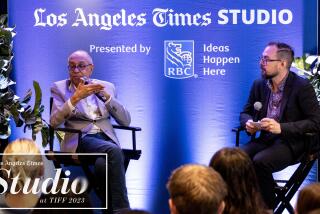Hollow Men
- Share via
With a few exceptions, Communism in post-Soviet Europe has been reduced to a handful of drab political groups shorn of their one-time power, mystique and relevance and of little concern to most of their countries’ citizenry and to other countries. The academic community in the West still boasts several “area studies” centers where the activities of post-Soviet Communist parties are scrutinized, as they are in several journals still devoted to developments in Eastern Europe.
But the days of the surviving European Communist parties are numbered. Even the Russian party, which only two or three years ago set off alarms with its blend of Marxist and chauvinist rhetoric, is increasingly dismissed as a wearisome nuisance.
Not so the communist past. Here interest is thriving, much of it encouraged by the opening of archives once unavailable to the public. New disclosures clearly support the view that the history of communism between 1917 and the end of the 1980s is not, as some scholars would have it, little more than a static blur in which the past merges with the present and the present is merely more of the same. Time and again, Communist parties were presented with options which, if implemented, could have changed not only their own history but that of Europe altogether. The insistence of several high-ranking leaders of the German party to form a common bloc with the Social Democrats (as urged, among others, by Leon Trotsky, who was already in exile at that time) against Hitler might have averted the Hitler catastrophe. Similarly, archival disclosures prove once more that there were communists in post-war Hungary who were opposed to the party’s ruthless elimination of all opposition, and had the Western powers realized and supported those forces both within and outside of the party, the satellization of Hungary might not have happened--or at least might have been temporarily derailed. (The West’s mistakes in general were of crucial role in the fate of communism in Eastern Europe.)
Each departure of a supreme leader, whether by accident, murder or, in the words of the late Bertram D. Wolfe, that “most unnatural death for a Bolshevik leader--a natural death,” limited the options available to his successor. You could never, as it were, “start from scratch.” On the other hand, no sooner did Stalin embark on his climb to power than he was faced with alternatives, few of which flowed ineluctably from the ideas and policies of his predecessor. Thus, he implemented the semi-capitalist New Economic Policy bequeathed to him by Lenin, but the manner of implementation was challenged by other Bolshevik leaders, such as Trotsky and Nikolai Bukharin, and had their advice been followed, Russia might well have evaded what came to be known as Stalinism with its pitiless brutality, huge economic setbacks and the creation of a totalitarian state.
Nor, to jump ahead several decades, was Stalinism possible without Stalin, which was what his heirs fully realized. It belabors the obvious to list respects in which Krushchev’s reign differed from Stalin’s or how Brezhnev broke with some of Krushchev’s policies, thus bringing about significant changes both in the USSR and in the international communist movement.
To be sure, the similarities among variants of communism throughout the world from the 1920s to the late 1980s were greater than their differences. The all-embracing ideology (whether given credence or not), the one-party state, the rejection of political pluralism, the persecution of political adversaries, the persistence of a centralized economy, even the continued veneration of the Maximum Leader after the “cult of personality” had been so resolutely trounced; all were perennial features of Communist systems.
But the developments of the late 1980s demonstrated at the very least--and paradoxically enough--the validity of the Marxist tenet that the accumulation of quantitative changes leads to changes in quality. For surely the changes in communism and then its demise followed from its evolution and not from any bankruptcy inherent in its inception.
“Fall of the New Class,” by Milovan Djilas, which appears barely two years after the death of the man who was first to write so forcefully about the rise of ruling classes in communist societies, bears out some of these observations. It is something of a pastiche that includes new material as well as recapitulations (and occasionally verbatim repetitions) of ideas that had appeared in earlier works by Djilas, especially “The New Class: An Analysis of the Communist System,” which first appeared in 1956, “Conversations with Stalin” and “Rise and Fall.” Not everything in the book, then, is either original or startling. But in addition to careful analyses, there are revealing insights into the personalities of the players with whom Djilas mingled during his years first as one of the top leaders of the Yugoslav Communist Party (or “League” as it renamed itself right after World War II) and whom he still knew intimately when he become the country’s foremost dissident.
One striking analysis in the book is Djilas’ discussion of Stalin, particularly Stalin and Stalinism’s connection to Lenin. This is still a matter of some importance, insofar as it elucidates the major ingredients of all successive chapters of communism and impinges on the still contentious issues such as the differences between totalitarianism and authoritarianism.
In the opinion of some students of communist affairs, Stalin broke decisively with Lenin and inaugurated a reign only tangentially related to Lenin’s ideas. The opposite view holds Stalin as a direct descendant of Lenin, a man who put into practice everything that Lenin preached and only half succeeded in bringing about. In this reading there was no essential difference between these two men and their respective isms.
Djilas, however, who during his tumultuous life had met Stalin several times and had ample time to reflect upon him both in prison, to which he was twice sent by Tito for a total of seven years, and out of prison takes a more nuanced position. In several sharply sketched and astutely argued pages, he makes a compelling case for Stalin as “the most consistent, most natural heir to Lenin.” “One could lay at Stalin’s door every conceivable sin,” he says at another point, “except that of betraying the structure of power Lenin had created.”
At the same time, Djilas makes it clear how Stalin’s mind-boggling brutality, his indiscriminate resort to mass terror, his crude interpretation of Marxist ideas and his complete estrangement from any strain of humanistic thinking all distinguished him vitally from his predecessor. Much like the historian Andrzej Walicki in his 1955 monumental study, “Marxism and the Leap to the Kingdom of Freedom,” Djilas illustrates “how much importance Stalin attached to [Marxist] ideas” while at the same time regarding them only as a means. Again and again Stalin felt compelled to justify his policies in ideological terms while “quite aware that the movement which had taken shape under his guidance had failed to correspond to any idea whatsoever.”
Still, the terror, the savagery, the relentless search for scapegoats continued--in the late 1920s, the 1930s and again after the war, when Soviet citizens anticipated some release from years of monstrous suffering. To what end? The question could legitimately be posed by Lenin, who indeed found it possible to call a halt to barbarous measures and even to turn to new policies, such as the semi-capitalist “New Economic Policy” introduced in 1922.
Not so in the case of Stalin, who continually reinvented the past and was hopelessly addicted to terror. He proclaimed that as the construction of “socialism” proceeded apace, so did the threat of “capitalist encirclement” (read: hostile anti-Soviet activity). So, in turn, did the need to strengthen the State and escalate terror. (According to Marx, the growth of socialism would bring about the “withering of the State” and of its coercive apparatus.) This, in a nutshell, captures the differences between the three men.
The same good sense that guides Djilas in illuminating the distinctions between Leninism and Stalinism also informs his discussion of the other men, from Khrushchev to Gorbachev, who continued and transformed the communist world. The sweep of his book takes in movements such as the New Left of the late 1960s, Chinese Communism and Mao Tse-tung, Charter 77 and other opposition groups in Eastern Europe and, of course, Djilas’ own one-time idol and then-nemesis, Joseph Broz Tito.
Each of these towering personalities and movements was different; each made contemporary communism much more than the unfolding of mere “historical stages.” The downfall of communism in Europe might have seemed miraculous, but it was not predictable. Indeed, no one had actually foreseen it, including those rabid right-wing enemies of communism who warned of its “ever-present danger,” scorning those “liberals” who argued that communism was not immutable (and later claimed that the end of communism had been obvious to them all along).
Djilas’ disenchantment, from his break with Tito over the lack of democracy in the party and servile attitude toward the Soviet Union in the early 1950s to his profound rejection of the whole legacy of communism several years later, remains one of the most stirring stories of our times. With the exception of the first years after World War II, Yugoslavia was always an idiosyncratic star in the communist firmament. Yet for all of its distinctiveness, it is still fascinating--or perhaps depressing is a better word--to read how virtually the whole party, including Djilas’ closest colleagues and friends, turned away from him when he was formally ostracized by Tito, very much as all the sundry “enemies of the people” were treated in the Soviet Union or the East European communist states. Similarly, for all of Tito’s criticism of Stalin, he cultivated a vulgar “cult of personality” very reminiscent of Stalin’s.
Then there was the curious habit of so many communist leaders to burst into tears at especially dramatic moments, such as during confrontations with erring comrades. Until recently, I assumed that Brezhnev’s bawling when he brought down his “good friend Sasha” (Czechoslovakia’s Alexander Dubcek) to Moscow in 1968 to berate him for so shamelessly betraying his Soviet benefactors was either an extraordinary piece of acting or a sign of Brezhnev’s advancing sclerosis--or both.
Yet Djilas describes how during the banquet in the Kremlin for the first meeting between the Yugoslav Partisans and the Soviet Politburo in Moscow in 1945, when the tensions between the two partners were beginning to emerge, Stalin shed copious tears as he rebutted Djilas’ criticism of the Soviet army in Yugoslavia--”Djilas, whom I welcomed as a brother!”--and Molotov following him with similar outpourings of “tragic pathos.”
Not to be outdone, two of the Yugoslav delegates, Arso Jovanovic and Andrija Hebrang, also wept, and even Djilas’ first wife, Mitra, “burst into tears. ‘How can you help crying,’ she later asked me upon returning to Belgrade, ‘when you see Stalin in tears?’ ” Such were the tawdry melodramas put on regularly by the hardy Bolshevik chiefs in the Kremlin.
“Fall of the New Class” is not a volume likely to elicit tears from the reader. But it certainly should provide one with several long hours of engrossing material.
More to Read
Sign up for Essential California
The most important California stories and recommendations in your inbox every morning.
You may occasionally receive promotional content from the Los Angeles Times.










